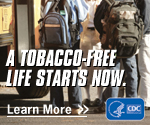History of the Surgeon General's Reports on Smoking and Health
On January 11, 1964, Luther L. Terry, M.D., Surgeon General of the U.S. Public Health Service, released the first report of the Surgeon General's Advisory Committee on Smoking and Health.
On the basis of more than 7,000 articles relating to smoking and disease already available at that time in the biomedical literature, the Advisory Committee concluded that cigarette smoking is—
- A cause of lung cancer and laryngeal cancer in men
- A probable cause of lung cancer in women
- The most important cause of chronic bronchitis
The release of the report was the first in a series of steps, still being taken more than 40 years later, to diminish the impact of tobacco use on the health of the American people.
For several days, the report furnished newspaper headlines across the country and lead stories on television newscasts. Later it was ranked among the top news stories of 1964.
During the more than 40 years that have elapsed since that report, individual citizens, private organizations, public agencies, and elected officials have pursued the Advisory Committee's call for "appropriate remedial action."
Early on, the U.S. Congress adopted the Federal Cigarette Labeling and Advertising Act of 1965 and the Public Health Cigarette Smoking Act of 1969. These laws—
- Required a health warning on cigarette packages
- Banned cigarette advertising in the broadcasting media
- Called for an annual report on the health consequences of smoking
In September 1965, the Public Health Service established a small unit called the National Clearinghouse for Smoking and Health.
Through the years, the Clearinghouse and its successor organization, the Centers for Disease Control and Prevention's Office on Smoking and Health, have been responsible for 29 reports on the health consequences of smoking.
In close cooperation with voluntary health organizations, the Public Health Service has—
- Supported successful state and community programs to reduce tobacco use
- Disseminated research findings related to tobacco use
- Ensured the continued public visibility of antismoking messages
Within this evolving social milieu, the population has given up smoking in increasing numbers. Nearly half of all living adults who ever smoked have quit.
The antismoking campaign is a major public health success with few parallels in the history of public health. It is being accomplished despite the addictive nature of tobacco and the powerful economic forces promoting its use.
However, more than 45 million American adults still smoke, more than 8 million are living with a serious illness caused by smoking, and about 438,000 Americans die prematurely each year as a result of tobacco use.
Efforts to implement proven interventions must be continued and expanded.
This material was compiled by the Office on Smoking and Health, National Center for Chronic Disease Prevention and Health Promotion, Centers for Disease Control and Prevention. Updated December 2006.
Contact Us:
- CDC/Office on Smoking and Health
4770 Buford Highway
MS K-50
Atlanta, Georgia 30341-3717 - 800-CDC-INFO
(800-232-4636)
TTY: (888) 232-6348
8am–8pm ET
Monday–Friday
Closed Holidays - tobaccoinfo@cdc.gov






